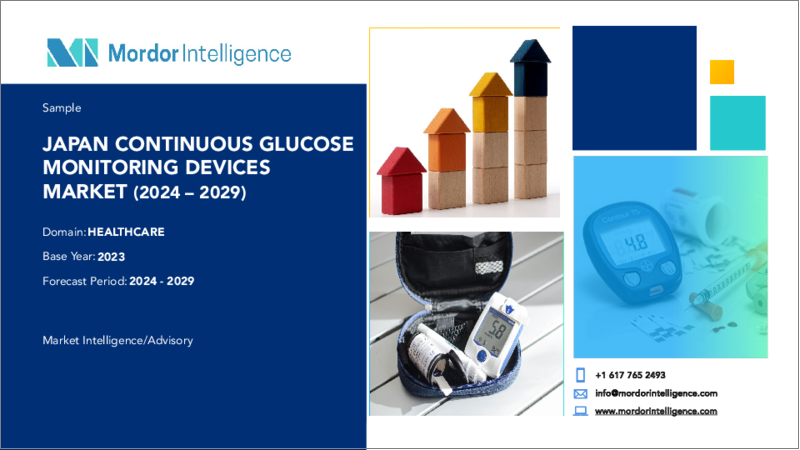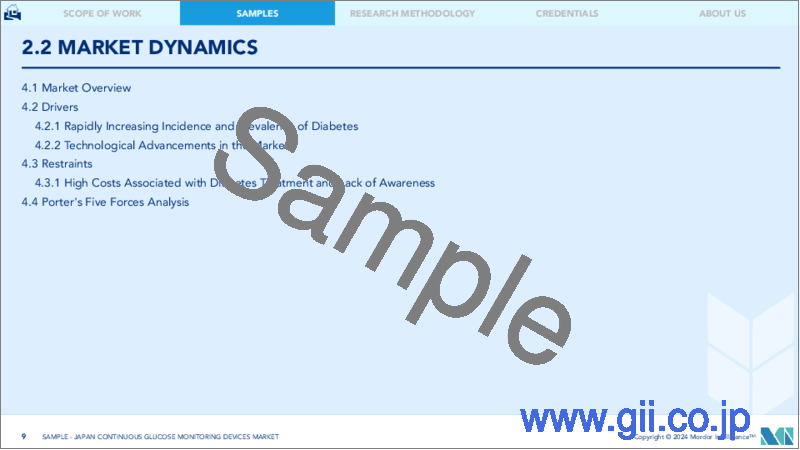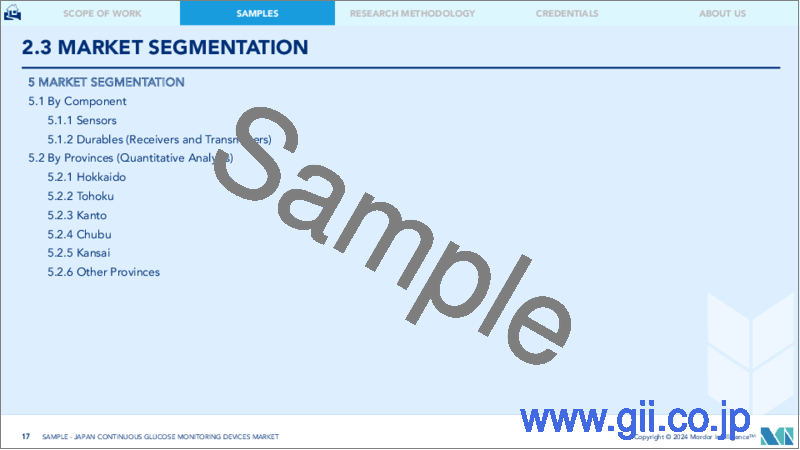|
|
市場調査レポート
商品コード
1408179
日本の持続グルコースモニタリング機器:市場シェア分析、産業動向と統計、2024~2029年の成長予測Japan Continuous Glucose Monitoring Devices - Market Share Analysis, Industry Trends & Statistics, Growth Forecasts 2024 - 2029 |
||||||
カスタマイズ可能
適宜更新あり
|
|||||||
| 日本の持続グルコースモニタリング機器:市場シェア分析、産業動向と統計、2024~2029年の成長予測 |
|
出版日: 2024年01月04日
発行: Mordor Intelligence
ページ情報: 英文 70 Pages
納期: 2~3営業日
|
全表示
- 概要
- 目次
日本の持続グルコースモニタリング機器市場規模は、2024年に9,612万米ドルと推定され、2029年には1億8,625万米ドルに達すると予測され、予測期間中(2024-2029年)のCAGRは10.99%で成長する見込みです。
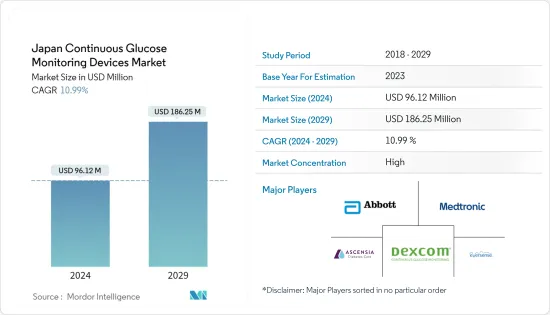
COVID-19は世界および日本の糖尿病業界のあらゆる側面を混乱させました。持続グルコースモニタリング装置の構成部品のほとんどが日本国外で製造されたため、複数の企業が日本全国で供給・流通チャネルの混乱に直面しました。このため、限られた在庫の中で機器の需要と供給の間にギャップが生じた。その結果、COVID-19の影響は、日本の糖尿病患者の持続的な継続的ケアへのアクセスに関して大きなものとなった。例えば、主要な洞察によれば、「COVID-19の大流行にもかかわらず、ほぼすべての日本の糖尿病患者が2~3ヵ月ごとに病院または診療所を受診していました。しかし、HCPは患者とのコミュニケーションが限られていたため、消費者基盤に影響を与え、新規ユーザーの獲得が困難でした。また、糖尿病治療を扱う企業が閉鎖され、病院・診療所を訪れた患者がHCPに製品情報を提供できなかった」(ライフスキャンジャパンの糖尿病ケア担当看護師)。
糖尿病は血糖値が高い慢性疾患です。インスリン(血糖値を一定に保つために膵臓で作られるホルモン)が分泌されないか、体がインスリンを効果的に使えないか、あるいはその両方によって引き起こされます。
1型糖尿病患者は、生涯を通じてインスリンを服用し、健康的な食事と定期的な運動を維持する必要があります。一方、2型糖尿病患者は、健康的な食事、身体的な活動、血糖値の検査が必要で、血液中のグルコースレベルをコントロールするために経口薬やインスリンの服用が必要になることもあります。糖尿病患者の間では、主に心血管疾患、脳卒中、血液障害、失明、腎臓障害などの合併症を避けるために、血糖値を監視する必要性が高まっています。
日本市場では様々な持続グルコースモニタリング機器が販売されています。Dexcom社は、現世代のG6 持続グルコースモニタリングを開発・製造しています。日本ではテルモがG6を販売しています。Dexcom G6システムは、ユーザーの腹部に装着するウェアラブルセンサーを特徴としています。グルコース測定値を5分ごとにモニターや専用アプリケーションを搭載したスマート機器に自動送信します。ユーザーは視覚化されたグラフを通じて、リアルタイムのグルコース値や動向を確認できます。さらに、グルコース測定値が事前に設定した目標範囲から外れると、G6がユーザーに通知します。また、20分以内に低血糖が発生すると予測される場合にはアラートを送信します。
日本の持続グルコースモニタリング機器市場動向
予測期間中、耐久消費財セグメントが最も高い成長率を示す見込み
トランスミッターは、血糖値をリーダー、レシーバー、またはスマートフォンアプリに送信するセンサーのコンポーネントです。レシーバーは、トランスミッターからデータを受信し、その結果をさまざまなユーザーインターフェースに表示する機器です。持続グルコースモニタリング機器のこれらのコンポーネントの動作方法は、メーカーによって異なります。これらの機器は目に見えることがあり、皮膚に装着する必要がある場合もあります。トランスミッターのバッテリーは充電式または使い捨ての場合があります。この市場セグメントは、糖尿病患者の間での持続グルコースモニタリング機器の使用の増加、糖尿病を引き起こす根本的な原因の増加、これらの製品の市場での入手可能性、これらの耐久消費財が提供する利点、および日本の人口の間での持続グルコースモニタリング機器の使用に関する意識の急増の結果として成長が見込まれています。
糖尿病は、日本の厚生労働省によってヘルスケアの優先事項として認識されています。2型糖尿病の高い有病率は、大きな経済的負担と関連しています。合併症の増加に伴い、費用は増加します。日本では医療保険制度が整備されており、糖尿病の医療費はすべてカバーされ、糖尿病患者は自由に医師の診察を受けることができます。
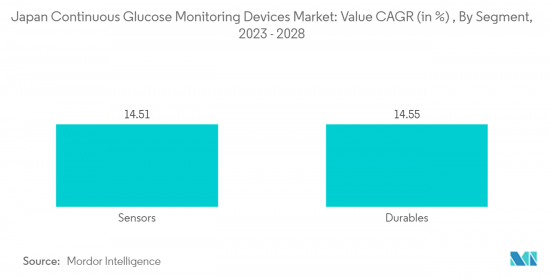
日本における糖尿病有病率の上昇が予測年の市場を牽引
日本の1型糖尿病人口は増加し、予測期間中のCAGRは0.4%を超えると予想されます。
日本では糖尿病の増加が急速に進んでいます。IDF 2021の推計によると、日本の成人1,100万人が糖尿病を患っています。糖尿病管理の目的は、高血糖に起因する代謝異常を改善し、糖尿病合併症や糖尿病に関連する疾患の発症や進行を予防し、罹患者が健常者と同等のQOLと余命を維持できるようにすることです。
日本糖尿病学会(JDS)は、HbA1cコントロールの目標を「7.0%未満」としています。同時に、日本糖尿病学会が作成した治療ガイドラインでは、HbA1cの一般的な治療目標は、治療リスクや患者の特性に応じて個別化することが推奨されています。
糖尿病有病率の増加に伴い、糖尿病そのものや合併症は、ヘルスケアシステムや社会に多大かつ増大する経済的負担をもたらします。2023年2月に神戸大学が発表したデータでは、糖尿病全体の有病率は9.7%です。糖尿病が生み出す潜在的な機会は、現在と将来の両方の環境において、すべての利害関係者にとって有益であり、最終的にこの市場で事業を展開する企業に数多くの可能性を生み出しています。
したがって、持続グルコースモニタリング機器の需要とその採用率も増加しています。これらの要因によって、調査された市場は促進されると予想されます。
日本の持続グルコースモニタリング機器産業の概要
日本の持続グルコースモニタリング機器市場は高度に統合されています。Dexcom、Abbott、Medtronicなどの市場リーダーは、市場での足場を固めるため、製品の発売や技術提携に注力しています。
その他の特典:
- エクセル形式の市場予測(ME)シート
- 3ヶ月間のアナリストサポート
目次
第1章 イントロダクション
- 調査の前提条件と市場定義
- 調査範囲
第2章 調査手法
第3章 エグゼクティブサマリー
第4章 市場力学
- 市場概要
- 市場力学
- 市場促進要因
- 市場抑制要因
- 業界の魅力- ポーター・ファイブ・フォース
- 供給企業の交渉力
- 消費者の交渉力
- 新規参入業者の脅威
- 代替品の脅威
- 競争企業間の敵対関係の強さ
第5章 市場セグメンテーション
- コンポーネント別
- センサー
- 耐久消費財(レシーバーとトランスミッター)
- 持続グルコースモニタリング機器ユーザー
- 北海道
- 東北
- 関東
- 中部
- 関西
- 中国
- 四国
- 九州
- 都道府県別
- 北海道
- 東北
- 関東
- 中部
- 関西
- 中国
- 四国
- 九州
- 官民別市場シェア
- 持続グルコースモニタリング機器の流通チャネル分析(病院、診療所、薬局、その他モードのシェア比率を含む)(2022年)
- 持続グルコースモニタリング機器処方者の分析(内分泌専門医、糖尿病専門医、その他のHCP専門医のシェア割合(2021年)、持続グルコースモニタリング機器に関する処方者の知識を含む)
第6章 市場指標
- 1型糖尿病人口
- 2型糖尿病人口
第7章 競合情勢
- 企業プロファイル
- Abbott Diabetes Care Inc.
- Dexcom Inc.
- Medtronic PLC
- Eversense
- Ascensia
- 企業シェア分析
- Abbott Diabetes Care Inc.
- Dexcom Inc.
- Medtronic PLC
- その他の企業
第8章 市場機会と今後の動向

The Japan Continuous Glucose Monitoring Devices Market size is estimated at USD 96.12 million in 2024, and is expected to reach USD 186.25 million by 2029, growing at a CAGR of 10.99% during the forecast period (2024-2029).
COVID-19 disrupted all aspects of the diabetes industry worldwide and in Japan. Several companies faced disruptions in supply and distribution channels nationwide since most of the CGM device components were manufactured outside of Japan. This created a gap between the supply and demand of the devices wherein the limited inventory was available. As a result, the impact of COVID-19 was considerable concerning access to a persistent continuum of care among the Japanese diabetic population. For instance, as per the primary insights, "Almost all Japanese diabetes patients visited their hospital or clinic every 2-3 months despite the COVID-19 pandemic. However, HCPs had limited communication with their patients, which impacted the consumer base and made it difficult to gain new users. In addition, the companies dealing in diabetes care were shut down, and patients visiting hospitals/clinics were unable to provide the product's information to HCPs" (Registered Nurse, Diabetes Care Japan, Lifescan).
Diabetes is a chronic condition marked by high blood glucose levels. It is caused either by the inability to produce insulin (a hormone made by the pancreas to keep blood glucose levels in range) or by the body not being able to use insulin effectively, or both.
Type 1 diabetic patients need to take insulin throughout their lives and maintain a healthy diet and regular physical exercise. Whereas Type 2 diabetic patients need to eat healthily, be physically active, and test their blood glucose level, and may also need to take oral medication and insulin to control the glucose level in their blood. The need for monitoring blood glucose levels is on the rise among diabetic patients, mainly to avoid complications, such as cardiovascular diseases, stroke, blood disorders, blindness, and kidney disorder, among others.
Various CGM devices are available in the japan market. Dexcom develops and manufactures the current-generation G6 CGM. Terumo markets the G6 in Japan. The Dexcom G6 system features a wearable sensor attached to a user's abdomen. It automatically transmits glucose measurements every five minutes to a monitor or smart device with a dedicated application. Users can check their real-time glucose values and trends through a visualized graph. Additionally, G6 notifies users when glucose measurements fall outside a pre-set target range. It also sends alerts upon predictions of hypoglycemia occurring in 20 minutes.
Japan Continuous Glucose Monitoring Devices Market Trends
The Durables Segment is Expected to Witness the Highest Growth Rate Over the Forecast Period
A transmitter is a component of a sensor that sends the blood glucose levels to the reader, receiver, or smartphone app. Receivers are devices that receive data from transmitters and display the results on different user interfaces. The way these components of CGM devices work varies according to their manufacturers. These devices can be visible and may be required to be placed on the skin. Transmitter batteries may be rechargeable or disposable. The market segment is expected to witness growth as a result of the growing use of CGM devices among the diabetic population, growing underlying causes resulting in diabetes, market availability of these products, advantages offered by these durables, and surge in awareness regarding the use of CGM devices among the Japanese population.
Diabetes has been identified as a healthcare priority by the Japanese Ministry of Health, Labour, and Welfare. The high prevalence of type 2 diabetes is associated with a significant economic burden. Costs increase with an increasing number of complications. Well-organized medical insurance systems cover all medical fees for diabetes mellitus, and diabetics can visit doctors freely in Japan.

Rising diabetes prevalence in Japan driving the market in the forecast year
The type 1 diabetic population in Japan is expected to increase, registering a CAGR greater than 0.4% over the forecast period.
There has been a rapid increase in the growth of diabetes in Japan. As per the IDF 2021 estimates, 11 million adults in Japan have diabetes. The objectives of diabetes management are to improve metabolic dysfunctions resulting from hyperglycemia to prevent the development or progression of diabetic complications and conditions associated with diabetes, and to enable affected individuals to maintain their quality of life and life expectancy at a level comparable to those in healthy individuals.
The Japan Diabetes Society (JDS) has set an HbA1c control target of 'less than 7.0%.' At the same time, treatment guidelines developed by the JDS recommend that the general treatment target for HbA1c should be individualized according to treatment risks and patient characteristics.
As the prevalence of diabetes increases, the condition itself and the associated complications generate a considerable and increasing economic burden on the healthcare system and society. Japan is reflecting this trend, facing a growing prevalence of T2D and T1D in the population, with an overall diabetes prevalence rate of 9.7%, as per the data published by a Kobe University study in February 2023. The potential opportunities that diabetes could generate, both in a present and future setting, are profitable for all stakeholders, ultimately creating numerous possibilities for the companies operating within the market.
Hence, the demand for continuous glucose monitoring devices and their adoption rate is also increasing. These factors are expected to drive the market studied.
Japan Continuous Glucose Monitoring Devices Industry Overview
The Japanese continuous glucose monitoring devices market is highly consolidated. Market leaders such as Dexcom, Abbott, and Medtronic are focusing on product launches and technological collaboration to increase their foothold in the market.
Additional Benefits:
- The market estimate (ME) sheet in Excel format
- 3 months of analyst support
TABLE OF CONTENTS
1 INTRODUCTION
- 1.1 Study Assumptions and Market Definition
- 1.2 Scope of the Study
2 RESEARCH METHODOLOGY
3 EXECUTIVE SUMMARY
4 MARKET DYNAMICS
- 4.1 Market Overview
- 4.2 Market Dynamics
- 4.2.1 Market Drivers
- 4.2.2 Market Restraints
- 4.3 Industry Attractiveness - Porter Five Forces
- 4.3.1 Bargaining Power of Suppliers
- 4.3.2 Bargaining Power of Consumers
- 4.3.3 Threat of New Entrants
- 4.3.4 Threat of Substitute Products and Services
- 4.3.5 Intensity of Competitive Rivalry
5 Market Segmentation
- 5.1 By Component
- 5.1.1 Sensors
- 5.1.2 Durables (Receivers and Transmitters)
- 5.2 CGM Device Users
- 5.2.1 Hokkaido
- 5.2.2 Tohoku
- 5.2.3 Kanto
- 5.2.4 Chubu
- 5.2.5 Kansai
- 5.2.6 Chugoku
- 5.2.7 Shikoku
- 5.2.8 Kyushu
- 5.3 By Provinces
- 5.3.1 Hokkaido
- 5.3.2 Tohoku
- 5.3.3 Kanto
- 5.3.4 Chubu
- 5.3.5 Kansai
- 5.3.6 Chugoku
- 5.3.7 Shikoku
- 5.3.8 Kyushu
- 5.4 Market Share by Public and Private
- 5.5 Analysis of CGM Devices Distribution Channels (Includes percentage share of Hospitals, clinics, Pharmacies, and other modes (2022))
- 5.6 Analysis of CGM devices prescribers (includes percentage share of Endocrinologists, Diabetologist, and other HCP specialties (2021), and Prescribers knowledge of CGM devices)
6 Market Indicators
- 6.1 Type-1 Diabetes Population
- 6.2 Type-2 Diabetes Population
7 COMPETITIVE LANDSCAPE
- 7.1 Company Profiles
- 7.1.1 Abbott Diabetes Care Inc.
- 7.1.2 Dexcom Inc.
- 7.1.3 Medtronic PLC
- 7.1.4 Eversense
- 7.1.5 Ascensia
- 7.2 Company Share Analysis
- 7.2.1 Abbott Diabetes Care Inc.
- 7.2.2 Dexcom Inc.
- 7.2.3 Medtronic PLC
- 7.2.4 Other Companies
